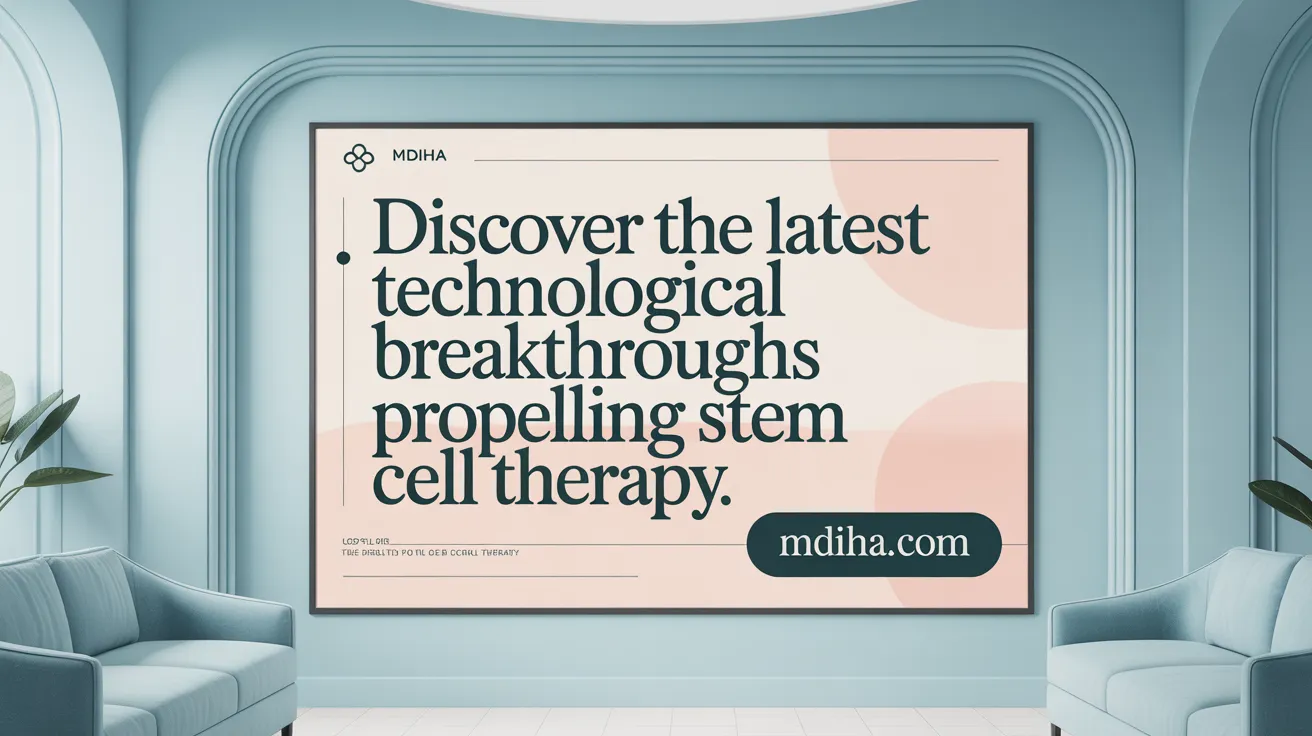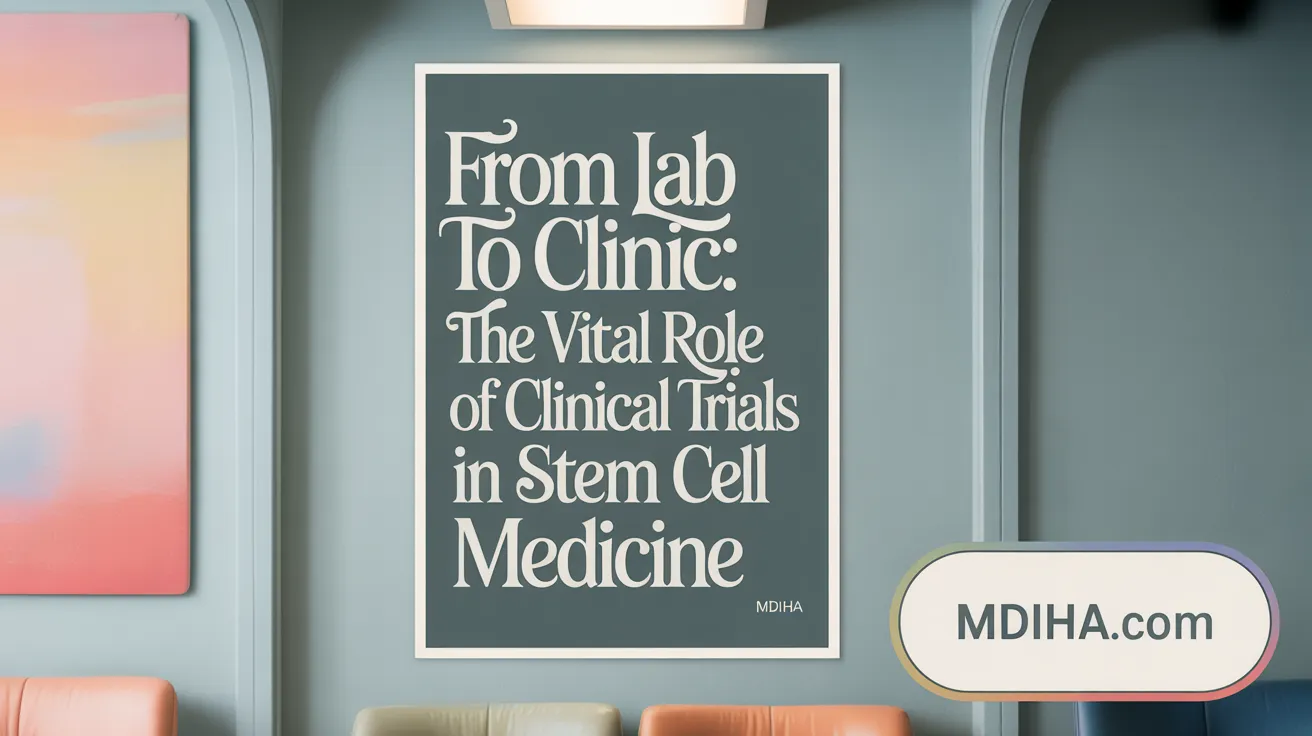Setting the Stage for Stem Cell Therapy Today
Stem cell therapy stands at the forefront of regenerative medicine, offering unprecedented possibilities for treating debilitating diseases and injuries. As this medical frontier expands, patients worldwide are beginning to experience its benefits and challenges firsthand. This article explores the latest scientific advances, clinical trial progress, patient experiences, and future prospects shaping how stem cell therapies are transforming care today.
Understanding Stem Cell Therapy: Types and Applications

What are the primary types of stem cells and their therapeutic uses?
Stem cells are mainly classified into four types: embryonic stem cells (ESCs), adult stem cells (ASCs), perinatal stem cells, and induced pluripotent stem cells (iPSCs).
-
Embryonic Stem Cells (ESCs): These are pluripotent, capable of differentiating into any human cell type and have a high capacity for self-renewal. ESCs hold great promise for tissue regeneration, disease modeling, drug testing, and developmental studies. However, their use raises ethical concerns due to their origin from early-stage embryos. See more on applications of ESCs and ethical concerns in stem cell therapy.
-
Adult Stem Cells (ASCs): These multipotent cells are found in various tissues and are primarily responsible for tissue maintenance and repair. Hematopoietic stem cells (HSCs) from bone marrow are the most clinically established ASCs, used widely to treat blood cancers and immune system disorders through bone marrow transplantation. For details on applications of ASCs and stem cell transplants for blood cancers, see the linked resources.
-
Perinatal Stem Cells: Derived from fetal tissues like the placenta and umbilical cord, these cells exhibit properties between ESCs and ASCs. They have the advantage of reduced immune rejection, making them promising for allogeneic transplantation. Learn more about applications of perinatal stem cells.
-
Induced Pluripotent Stem Cells (iPSCs): These are adult cells reprogrammed to a pluripotent state, similar to ESCs, allowing for personalized treatments. iPSCs circumvent ethical concerns related to ESCs and enable disease modeling and drug discovery. For more on induced pluripotent stem cells and iPSC applications, see the references.
What are regenerative medicine uses and therapeutic mechanisms?
Stem cell therapy plays a pivotal role in regenerative medicine by harnessing stem cells' abilities to regenerate damaged tissues and modulate immune responses. They achieve healing through:
- Differentiation into specialized cell types to replace diseased or injured cells.
- Secretion of bioactive factors and exosome-based therapeutics that exert immunomodulatory, antiapoptotic, antibacterial, and tissue repair effects.
- Migration and homing to injured tissues and remodeling of the extracellular matrix.
These therapeutic mechanisms of stem cells are being explored for diseases including neurodegenerative disorders, cardiovascular disease, diabetes, orthopedic injuries, and autoimmune disorders.
What current stem cell treatments are approved?
The only FDA-approved stem cell therapies to date are hematopoietic stem cell transplants, used primarily to treat certain blood and immune system cancers such as leukemia, lymphoma, and multiple myeloma. Other stem cell-based treatments are experimental and are being tested in numerous clinical trials worldwide.
What does the clinical trial landscape look like?
Stem cell therapies are under active investigation through early to late stage clinical trials for a variety of conditions. Trials explore safety, efficacy, dosage, and delivery methods for diseases like Parkinson’s (see stem-cell therapy for Parkinson's), Alzheimer’s, spinal cord injuries, diabetes, cardiovascular disorders, and COVID-19-related complications. These trials use diverse stem cell types including iPSCs, ESCs, adult stem cells, and engineered cellular therapies.
Ongoing research advances and biotechnological innovations continue to expand the therapeutic potential of stem cells. This evolving field holds considerable promise for future personalized regenerative therapies across a broad spectrum of diseases.
Recent Innovations Driving Stem Cell Therapy Forward

What technological advances are advancing stem cell therapy?
Stem cell therapy has rapidly progressed owing to several groundbreaking biotechnological innovations in stem cell research. One major advance is the use of CRISPR-Cas9 gene editing in stem cells, which allows precise correction of mutations in stem cells. This technology enhances therapy safety and opens up personalized treatment avenues by tailoring cells to patient-specific requirements.
Another leap forward is the development of organoids, which are three-dimensional, miniature models of human tissues grown from stem cells. These organoids help scientists study complex diseases in a controlled environment, improving drug testing and regenerative medicine approaches.
Exosome-based therapeutics exploit tiny vesicles secreted by stem cells which carry important signaling molecules. These exosomes can mimic many benefits of stem cell therapy, such as immunomodulation and tissue repair, without the risks linked to cell transplantation.
Research in microgravity effects on stem cells conditions aboard the International Space Station has uncovered unique stem cell properties invisible under normal gravity. These findings could accelerate the design of novel biotherapies and improve healing of difficult-to-treat diseases.
Together, these advances are enhancing the understanding, safety, and effectiveness of stem cell therapies, pushing the frontier of regenerative medicine into promising new territories.
Patients' Real-World Experiences with Stem Cell Therapies

What motivates patients to pursue stem cell therapies?
Patients facing severe or life-threatening conditions often turn to stem cell therapies driven by hope for stabilization or improvement when standard options fall short. The urgency of their health status and limited access to experimental treatments fuel this pursuit.
What is stem cell tourism and why do patients engage in it?
Stem cell tourism refers to patients traveling across borders to receive treatments not approved or available in their home countries. This practice arises due to regulatory differences, cost factors, and perceived treatment quality, but it introduces legal, safety, and ethical complexities.
What benefits and risks do patients report?
Many patients describe initial alleviation of symptoms such as pain reduction, improved mobility, or functional gains. However, these benefits tend to be subjective and often lack rigorous clinical validation. The unregulated nature of some treatment clinics poses risks including ineffective therapies, safety concerns, and potential exploitation, detailed in Patients' experiences with stem cell therapies.
What challenges do regulatory bodies face?
Regulatory oversight of stem cell therapies is complicated by the biological complexity of living cells and their diverse clinical applications. Traditional frameworks struggle with categorizing these treatments, complicating enforcement and protection of patients against unproven procedures, as discussed in Regulatory difficulties for stem cell treatments.
How do patients perceive treatment outcomes?
Some patients report meaningful improvements and advocate for regulated access to autologous stem cell therapies, where cells are harvested and reinfused from the same individual. They emphasize that such regulation would enhance safety, efficacy data collection, and informed patient decision-making.
Overall, patient experiences underscore the need for enhanced regulation, transparency, and clinical validation to balance hope with safety and reliable therapeutic benefits in stem cell therapies.
Clinical Trials: Bridging Research and Patient Care

Clinical trial phases
Stem cell therapies undergo comprehensive clinical testing through four phased trials. Phase I primarily evaluates safety, dosage, and side effects in small patient groups. Phase II expands to assess efficacy and optimal dosage alongside monitoring adverse reactions. Phase III involves larger populations to confirm effectiveness and pave the way for regulatory approval. Lastly, Phase IV focuses on long-term monitoring after the treatment hits the market to evaluate ongoing safety and benefits. See more on Phases of Clinical Trials.
Conditions under investigation
Numerous clinical trials target a wide range of diseases utilizing stem cell-based approaches. These include neurodegenerative disorders such as Parkinson’s and multiple sclerosis, various cancers including blood and solid tumors, cardiovascular diseases, diabetes, and autoimmune conditions. Specialized trials are also exploring spinal cord injury repair and innovative treatments for inflammatory and orthopedic disorders. Refer to Stem-Cell Therapy for Parkinson's and Clinical Trials in Stem Cell Therapy.
Safety and efficacy data
Data emerging from early-phase clinical trials demonstrate encouraging safety profiles and functional outcomes. For example, Parkinson’s disease trials utilizing induced pluripotent stem cell-derived dopaminergic neurons reported no serious adverse effects or tumor formation, alongside notable motor improvements and increased dopamine activity. Additionally, novel conditioning protocols employing antibody treatment to prepare patients for stem cell transplants have shown reduced toxicity and successful donor cell engraftment. More details can be found at Stem Cell Therapy Risks and Benefits, Stanford Medicine Stem Cell Transplant Clinical Trial, and Stem-cell therapy overview and challenges.
Institutions leading research
Pioneering institutions such as UCLA Broad Stem Cell Research Center, UC San Diego’s Sanford Stem Cell Clinical Center, and Mayo Clinic are at the forefront of stem cell clinical research. These centers conduct trials with rigorous methodologies, often incorporating innovative cell types, delivery methods, and long-term follow-up to ensure safety and maximize therapeutic potential. For insights, see UCLA Broad Stem Cell Research Center Clinical Trials, Sanford Stem Cell Clinical Center trials, and Mayo Clinic 3D human intestines organoids.
Emerging therapy examples
Recent trials showcase groundbreaking advancements including iPSC-derived treatments for Parkinson’s disease, antibody-based stem cell transplant conditioning for genetic blood disorders, and CAR T-cell immunotherapies for cancer. Furthermore, exploration of exosome-based therapeutics and use of stem cells grown in microgravity environments represent cutting-edge avenues that could accelerate clinical benefits. Learn more at Stem cell therapy breakthroughs 2024, Stem cell therapy in microgravity and exosome-based therapeutics, and Recent developments in stem-cell therapy.
Clinical trials are pivotal in bridging laboratory discoveries and patient care by validating stem cell safety and efficacy. Continued research at leading institutions promises to expand regenerative medicine’s reach across diverse and challenging diseases, paving the way for personalized and innovative treatments. For a comprehensive overview on clinical trials of stem cell therapies, see additional resources.
Success Rates and Measuring Outcomes in Stem Cell Therapy
What do current data indicate about the success of stem cell therapies?
Success rates in stem cell therapy differ widely based on the disease being treated and the stem cell type used. For hematopoietic stem cell transplants, commonly applied to blood cancers, survival rates range from approximately 72% to 92% at three years post-treatment. In regenerative medicine, particularly for joint, autoimmune, and inflammatory conditions, patient-reported success rates hover near 80%. These patients often note improvements in stamina, energy, balance, coordination, and cognitive functions such as memory and concentration. For more detailed statistics on stem cell therapy success rate overview, see DVC Stem’s data on outcomes and patient experiences.
How are outcomes measured in stem cell treatments?
Outcomes are assessed through a combination of clinical evaluations, laboratory tests, and patient-reported experiences. Clinical measures include symptom reduction and objective improvements, while lab tests may track inflammatory markers and cell function. Subjective feedback captures patients' perceived quality of life and functional gains. Such assessment approaches align with protocols outlined in Stem Cell-Based Therapies in Clinical Trials and considerations discussed in Stem Cell Therapy Benefits and Risks.
What long-term benefits and limitations do patients experience?
Most patients observe significant benefits within three to six months after treatment, with some sustaining improvements for several years. However, stem cell therapies are not always permanent; some cases may require additional treatments to maintain or improve results. Limitations include variability in response between patients and risks such as immune rejection or tumorigenicity in stem cell therapy in rare cases. These points are addressed in the literature on clinical challenges in stem-cell therapy and stem cell therapy risks.
What factors influence the success of stem cell therapy?
Therapeutic effectiveness depends on several factors:
- Stem cell source: Embryonic, adult, or induced pluripotent cells have different potentials and risks; see types of stem cells and their applications.
- Patient health status: Overall health and immune compatibility affect outcomes.
- Condition severity: More advanced or complex diseases may be harder to treat.
- Processing and administration: Techniques in harvesting, dosing, and delivery impact efficacy.
- Post-treatment care: Rehabilitation and monitoring support sustained recovery.
Ongoing advances in stem cell harvesting, storage, and treatment protocols promise to enhance success rates and broaden the scope of stem cell therapies in the near future, as discussed in the review on biotechnological advances in stem cell research and future directions in regenerative medicine.
Ethical, Regulatory, and Safety Considerations
What ethical and regulatory issues affect stem cell therapy today?
Stem cell therapy raises significant ethical debates, primarily surrounding the use of embryonic stem cells (ESCs). Since ESCs are derived from early-stage embryos, their use involves the destruction of embryos, which many view as ethically contentious. This has led to increasing preference for alternatives like induced pluripotent stem cells (iPSCs), which provide similar therapeutic potential without the moral concerns linked to embryo use.
Globally, regulatory frameworks for stem cell therapies differ widely. Some countries have strict, well-defined regulations, while others have more permissive or unclear guidelines. This inconsistency enables the emergence of unregulated clinics offering unproven or experimental stem cell treatments, often referred to as "stem cell tourism".
These unregulated treatments carry serious risks including tumorigenicity in stem cell therapy, immune rejection, infections, and lack of verified efficacy. Patients seeking such therapies may be vulnerable to misinformation and may not receive adequate warnings about safety.
Efforts to improve oversight include calls for rigorous accreditation of clinics, standardized protocols for cell preparation and administration, transparent patient reporting, and enforcement of regulations to ensure treatments meet safety and efficacy standards. However, governing stem cell products is challenging because living cells do not fit neatly into conventional drug categories, requiring flexible and nuanced regulatory approaches.
Balancing innovation with patient protection means supporting research and clinical trials while preventing exploitation and harm. This includes fostering ethical research, promoting alternatives to ethically sensitive cells, and enhancing public awareness about proven versus unproven therapies. Ultimately, advancing stem cell therapy safely demands global collaboration between regulators, scientists, and healthcare providers.
Advances in Personalized and Precision Medicine with Stem Cells
How are personalized medicine and stem cell advances converging?
Personalized medicine is rapidly integrating with stem-cell therapy overview to revolutionize treatment approaches. Genomic analyses, including large-scale Tapestry exome study and genetics such as those conducted by major research centers, are enabling clinicians to understand the genetic profile of patients more deeply. This insight allows for the customization of stem cell therapies tailored to individual genetic backgrounds, enhancing treatment specificity and safety.
One of the most transformative tools in this convergence is CRISPR-Cas9 gene editing in stem cells. It enables precise correction of patient-specific genetic mutations within stem cells, improving treatment outcomes while minimizing risks like immune rejection or unintended cell behavior. The development of universal donor induced pluripotent stem cells (iPSCs) offers the potential for off-the-shelf, immunocompatible stem cell products that can be used broadly without the need for matching.
Artificial intelligence plays a critical role by supporting hypothesis-driven treatment planning. AI algorithms analyze complex biological data to predict the most effective stem cell therapies for individual patients, guiding clinicians toward optimized, personalized regimens.
Looking ahead, bioengineering of tissues and organs with stem cells holds promise for fabricating patient-specific tissues and even entire organs. Advances in growing Mayo Clinic 3D human intestines organoids and utilizing stem-cell derived constructs may ultimately enable replacement of damaged tissues with fully compatible, customized solutions, dramatically improving transplant success and patient outcomes.
Together, these advances are building a future where regenerative medicine is safer, more effective, and tuned precisely to the unique needs of every patient.
Looking Ahead: The Future Landscape of Stem Cell Therapy

What future developments are anticipated in stem cell therapy?
Stem cell therapy is poised for a transformative leap, with future advances centered around enhancing safety, efficacy, and accessibility. Gene editing techniques, especially CRISPR-Cas9 gene editing in stem cells, will be refined to reduce off-target effects and boost precision in modifying stem cells for personalized treatments. Immune modulation strategies will evolve, aiming to minimize rejection risks through advanced conditioning approaches like antibody-based protocols that reduce toxic chemotherapy use.
Emerging therapies focus heavily on neurodegenerative diseases such as Parkinson’s and Alzheimer’s, where stem cells can replace damaged neurons and modulate inflammation (stem cell therapy for neurological disorders, stem-cell therapy for Parkinson's, stem cell therapy for Alzheimer's disease). Cardiovascular repair is another promising area, with stem cells differentiating into cardiomyocytes to regenerate heart tissue and reduce scarring (stem cell therapy for cardiovascular diseases). Diabetes treatment continues to advance with the use of induced pluripotent stem cells to produce insulin-secreting beta cells. Cancer immunotherapies are incorporating stem cell-derived immune cells for targeted attacks on tumors (stem cells in cancer treatment.
Addressing clinical challenges, innovations are underway to mitigate tumorigenicity in stem cell therapy, and ensure precise control over stem cell differentiation (challenges in stem-cell therapy. Efforts to standardize protocols, improve scalability, and establish robust regulatory frameworks will facilitate wider adoption and ensure patient safety (Regulatory Compliance in Clinical Trials). Advances in bioengineering of tissues and organs with stem cells are enabling the growth of functional tissues and organs, expanding the potential of regenerative medicine beyond cell replacement to full organ regeneration.
Patient access and affordability remain pivotal focuses. Development of universal donor stem cell lines aims to provide ready-to-use therapies, while AI and population genomics integration will accelerate the customization of treatments tailored to individual genetic profiles (integration of stem-cell therapy with precision medicine, population genomics and genome sequencing expansion). These advances promise to democratize stem cell therapy, making it safer and more accessible globally.
In summary, the future landscape of stem cell therapy leverages cutting-edge biotechnologies and clinical innovations to overcome current limitations. This integrated approach promises to revolutionize treatments for a broad range of diseases, offering hope for more effective, durable, and personalized regenerative medicine solutions (future prospects of stem-cell therapy.
Charting a Path Forward for Patients and Providers
Stem cell therapy has transitioned from experimental hope to a tangible, evolving reality impacting patient care worldwide. While safety, ethical, and regulatory challenges remain, scientific and clinical advancements continue to expand therapeutic options and improve outcomes for diverse conditions. Patients’ experiences highlight both the promise and the risks of current treatments, underscoring the necessity for rigorous clinical validation and compassionate regulation. As innovations in gene editing, personalized medicine, and bioengineering converge, the potential to revolutionize healing and extend healthy longevity grows ever closer. Ensuring equitable access and informed patient engagement will be paramount as this remarkable field continues to shape the future of medicine.
